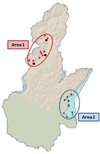A new non-destructive method for chemical analysis of particulate matter filters: the case of manganese air pollution in Vallecamonica (Italy)
- PMID: 21315919
- PMCID: PMC3056347
- DOI: 10.1016/j.talanta.2010.12.048
A new non-destructive method for chemical analysis of particulate matter filters: the case of manganese air pollution in Vallecamonica (Italy)
Abstract
Total Reflection X-ray Fluorescence (TXRF) is a well-established technique for chemical analysis, but it is mainly employed for quality control in the electronics semiconductor industry. The capability to analyze liquid and uniformly thin solid samples makes this technique suitable for other applications, and especially in the very critical field of environmental analysis. Comparison with standard methods like inductively coupled plasma (ICP) and atomic absorption spectroscopy (AAS) shows that TXRF is a practical, accurate, and reliable technique in occupational settings. Due to the greater sensitivity necessary in trace heavy metal detection, TXRF is also suitable for environmental chemical analysis. In this paper we show that based on appropriate standards, TXRF can be considered for non-destructive routine quantitative analysis of environmental matrices such as air filters. This work has been developed in the frame of the EU-FP6 PHIME (Public Health Impact of long-term, low-level Mixed element Exposure in susceptible population strata) Integrated Project (www.phime.org). The aim of this work was to investigate Mn air pollution in the area of Vallecamonica (Italy).
Copyright © 2011 Elsevier B.V. All rights reserved.
Figures




References
-
- Englert N. Toxicol. Lett. 2004;149:235–242. - PubMed
-
- Spurny KR. Toxicol. Lett. 1996;88:271–277. - PubMed
-
- Höhr D, Steinfartz Y, Schins RPF, Knaapen AM, Martra G, Fubini B, Borm PJ. Int. J. Hyg. Environ. Health. 2002;205:239–244. - PubMed
-
- Burnett RT, Brook J, Dann T, Delocla C, Philips O, Cakmak S, Vincent R, Goldberg MS, Krewski D. Inhal. Toxicol. 2000;12:15–39. - PubMed
Publication types
MeSH terms
Substances
Grants and funding
LinkOut - more resources
Full Text Sources
Medical

